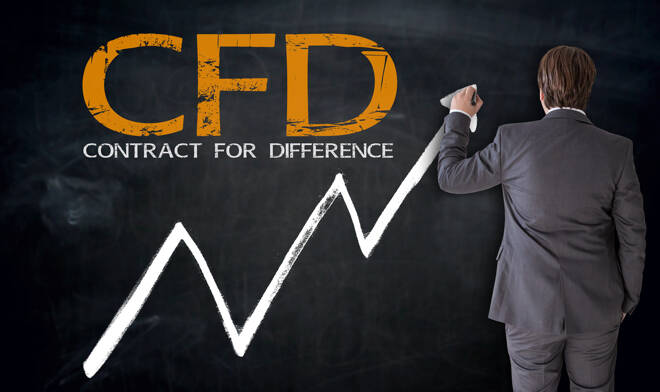Advertisement
Advertisement
Benefits of Contracts for Differences
By:
Contracts for difference (CFDs) are financial derivative instruments that track many assets, including forex, equity shares, commodities, indices, and cryptocurrencies.
In this article:
CFDs allow forex traders to take long or short exposure using leverage and settle the transaction with cash, rather than delivery of physical assets. These instruments differ from buying or selling the underlying asset because the contract holder doesn’t need to post 100% of capital and does not own the asset. CFDs are not allowed in the United States.
The CFD trading stake only needs to cover the net change from the entry price to the exit price. Compare this to a forex broker who requires a higher percentage of capital in the account to buy or sell currency pairs. CFDs can be used to trade directionally, or you can buy one CFD and simultaneously sell another CFD, capturing the relative change in value in a ‘pairs trade’.
KEY POINTS
- Contracts-for-difference are derivative instruments that track many assets.
- CFDs provide leverage based on the buy and sell price, rather than the underlying assets.
- CFDs support greater total exposure than forex cash markets.
- EU rules limit the margin on forex CFDs to 30:1 on major pairs and 20:1 on minor pairs.
- Limit CFD exposure on a single trade to a small percentage of total capital.
Do CFDs Provide Leverage?
The contract for difference has an embedded leverage feature that differs from broker to broker, and asset to asset. Leverage increases both trading profits and trading losses, allowing the market participant to take an exposure with borrowed capital. Current European Union regulations limit leverage on major currency pairs to 30: 1 and minor currency pairs to 20: 1. In addition, those rules provide negative balance protection so the trading account never goes below zero.
Forex contracts for difference are bought or sold in standard, mini, or micro ‘lots’, or unit sizes, that correspond with $100,000, $10,000, or $1,000 of the underlying forex pair, respectively. So, for example, a broker following EU rules will allow the trader to purchase three EUR/USD CFD mini lots ($30,000) while posting collateral (free account capital) of just $1,000.
It’s important to understand how leverage will impact your trading returns, positively and negatively. For example, if you purchase $30,000 of EUR/USD using 30: 1 leverage in a $1,000 account, it will take just a 3.33% ($30,000 * .0333) move to either double your money or wipe out your capital. So, while leverage is an attractive tool, it’s also a double-edged sword.
To use leverage, the trader needs to open a ‘margin’ account as opposed to a ‘cash’ account. Each broker has different criteria for opening a margin account but most require a higher minimum stake than a cash account. In addition, the applicant may need to answer questions about trading experience and investment knowledge.
After opening a margin account, the trader needs to maintain a specific amount of capital. Each position requires the account holder to post a specific amount of funds from this capital pool, referred to as ‘initial margin’. This is the money needed to cover the loss if the trade doesn’t work out as expected.
The broker will ensure the account holder has funds to cover potential losses or positions will be closed automatically to cover the deficit. As the market moves, the amount of margin needed to maintain the trade will change. If the value of the position decreases, the broker will take a ‘maintenance margin’ to cover losses in addition to the initial margin. If the value of the position increases, the initial margin will remain unchanged, but the maintenance margin will decline.
The margin calculation is in real-time, telling the broker the minimum amount of capital required for the account holder to maintain the trade. If the position moves against the trader and account capital isn’t increased, the broker has the right to liquidate the position. It’s vital that new forex traders understand the written margin agreement and the broker’s rights to liquidate positions before starting to trade CFDs.
Managing Your Risk
Trading CFDs can be risky, especially if you use leverage, so a written trading plan (trading rules) must be in place before entering a position (see ‘Psychology and Trading’). Limit the amount of individual trade exposure to a small percentage of the total account size, providing a measure of safety as your trading skills grow. Place stops on all trades, cut your losses and, if the market moves in your favor, adjust the stop and lock in some profits.
Summary
Contracts for difference (CFDs) are financial derivatives that allow market participants to trade the forex market without purchasing or selling currency pairs. CFD pricing tracks underlying assets and provides leverage to enhance returns. Trading CFDs requires opening a margin account at a CFD broker. Leverage can significantly enhance forex trading returns but will also generate damaging losses, especially when applied incorrectly. A well-constructed risk management plan is needed to trade CFDs for consistent profits.
About the Author
Alan Farleyauthor
Alan Farley is the best-selling author of ‘The Master Swing Trader’ and market professional since the 1990s, with expertise in balance sheets, technical analysis, price action (tape reading), and broker performance.
Latest news and analysis
Advertisement
